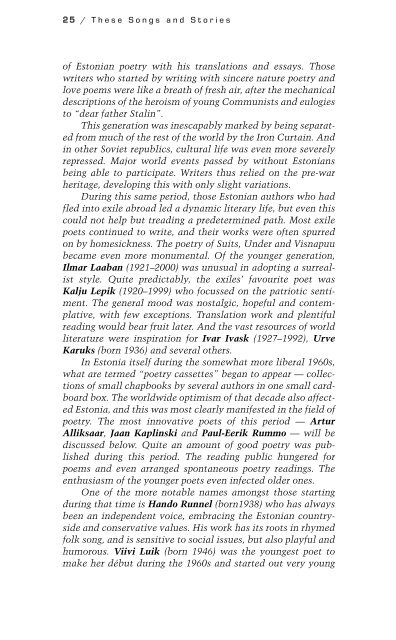*tuule makett - Infopoint Estonian Culture
*tuule makett - Infopoint Estonian Culture
*tuule makett - Infopoint Estonian Culture
Create successful ePaper yourself
Turn your PDF publications into a flip-book with our unique Google optimized e-Paper software.
2 5 / These Songs and Stories<br />
of <strong>Estonian</strong> poetry with his translations and essays. Those<br />
writers who started by writing with sincere nature poetry and<br />
love poems were like a breath of fresh air, after the mechanical<br />
descriptions of the heroism of young Communists and eulogies<br />
to “dear father Stalin”.<br />
This generation was inescapably marked by being separated<br />
from much of the rest of the world by the Iron Curtain. And<br />
in other Soviet republics, cultural life was even more severely<br />
repressed. Major world events passed by without <strong>Estonian</strong>s<br />
being able to participate. Writers thus relied on the pre-war<br />
heritage, developing this with only slight variations.<br />
During this same period, those <strong>Estonian</strong> authors who had<br />
fled into exile abroad led a dynamic literary life, but even this<br />
could not help but treading a predetermined path. Most exile<br />
poets continued to write, and their works were often spurred<br />
on by homesickness. The poetry of Suits, Under and Visnapuu<br />
became even more monumental. Of the younger generation,<br />
Ilmar Laaban (1921–2000) was unusual in adopting a surrealist<br />
style. Quite predictably, the exiles’ favourite poet was<br />
Kalju Lepik (1920–1999) who focussed on the patriotic sentiment.<br />
The general mood was nostalgic, hopeful and contemplative,<br />
with few exceptions. Translation work and plentiful<br />
reading would bear fruit later. And the vast resources of world<br />
literature were inspiration for Ivar Ivask (1927–1992), Urve<br />
Karuks (born 1936) and several others.<br />
In Estonia itself during the somewhat more liberal 1960s,<br />
what are termed “poetry cassettes” began to appear — collections<br />
of small chapbooks by several authors in one small cardboard<br />
box. The worldwide optimism of that decade also affected<br />
Estonia, and this was most clearly manifested in the field of<br />
poetry. The most innovative poets of this period — Artur<br />
Alliksaar, Jaan Kaplinski and Paul-Eerik Rummo — will be<br />
discussed below. Quite an amount of good poetry was published<br />
during this period. The reading public hungered for<br />
poems and even arranged spontaneous poetry readings. The<br />
enthusiasm of the younger poets even infected older ones.<br />
One of the more notable names amongst those starting<br />
during that time is Hando Runnel (born1938) who has always<br />
been an independent voice, embracing the <strong>Estonian</strong> countryside<br />
and conservative values. His work has its roots in rhymed<br />
folk song, and is sensitive to social issues, but also playful and<br />
humorous. Viivi Luik (born 1946) was the youngest poet to<br />
make her début during the 1960s and started out very young


